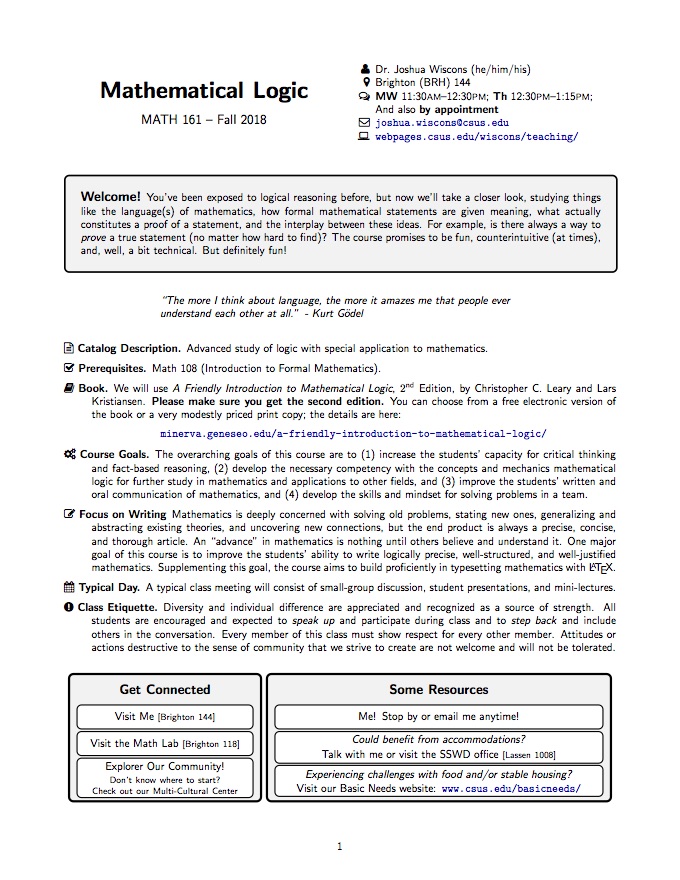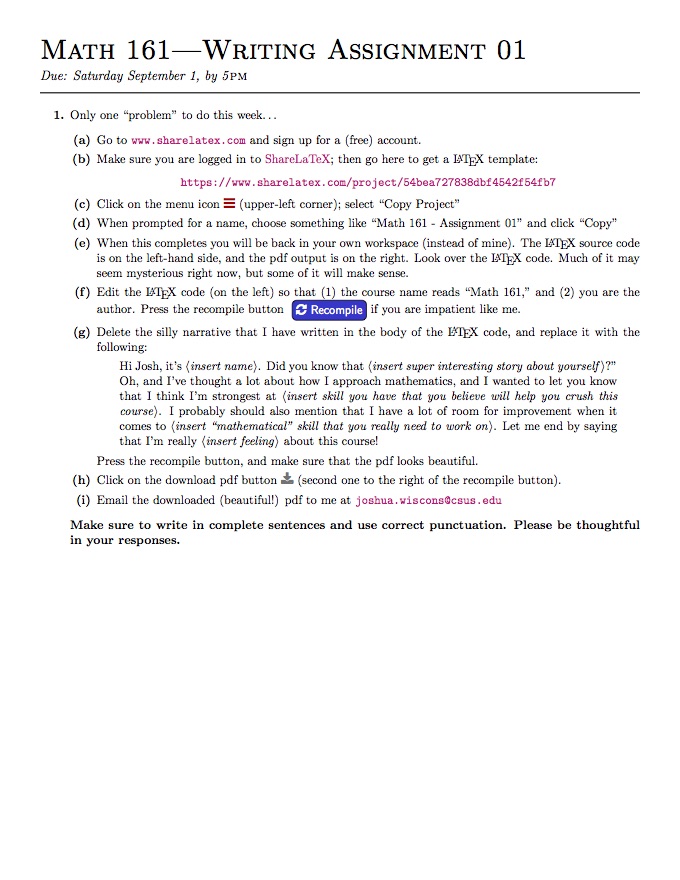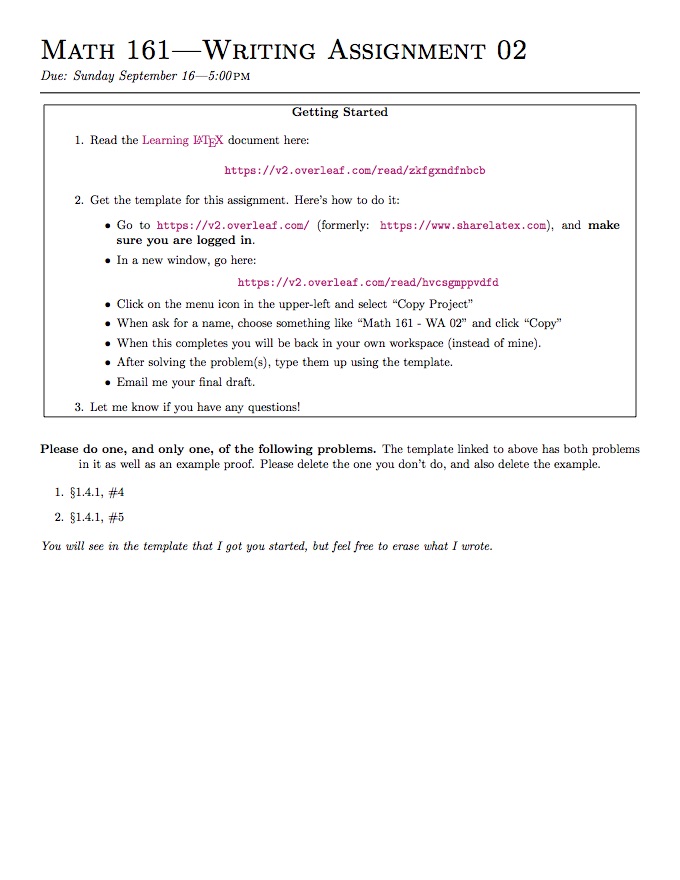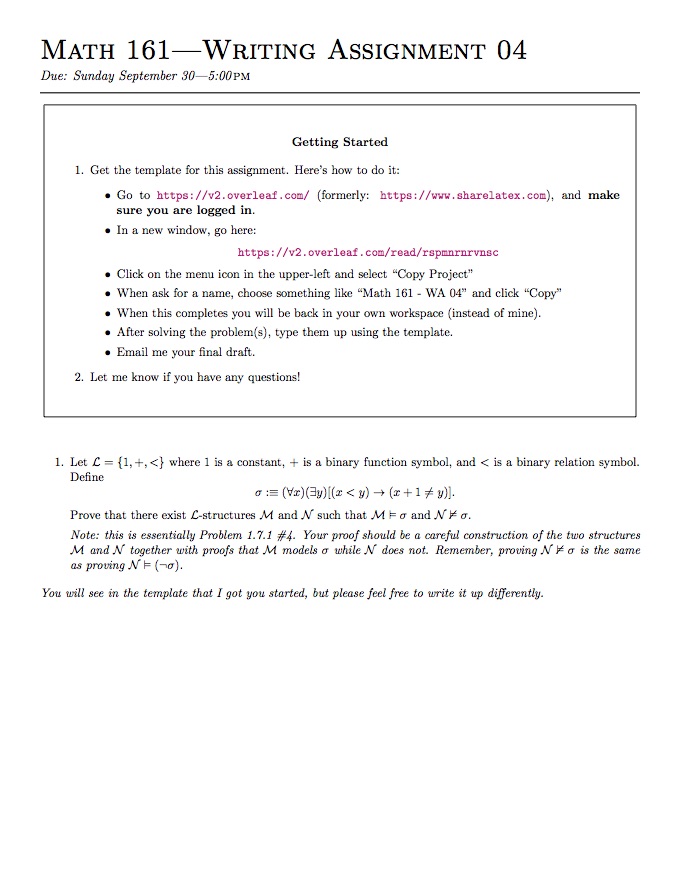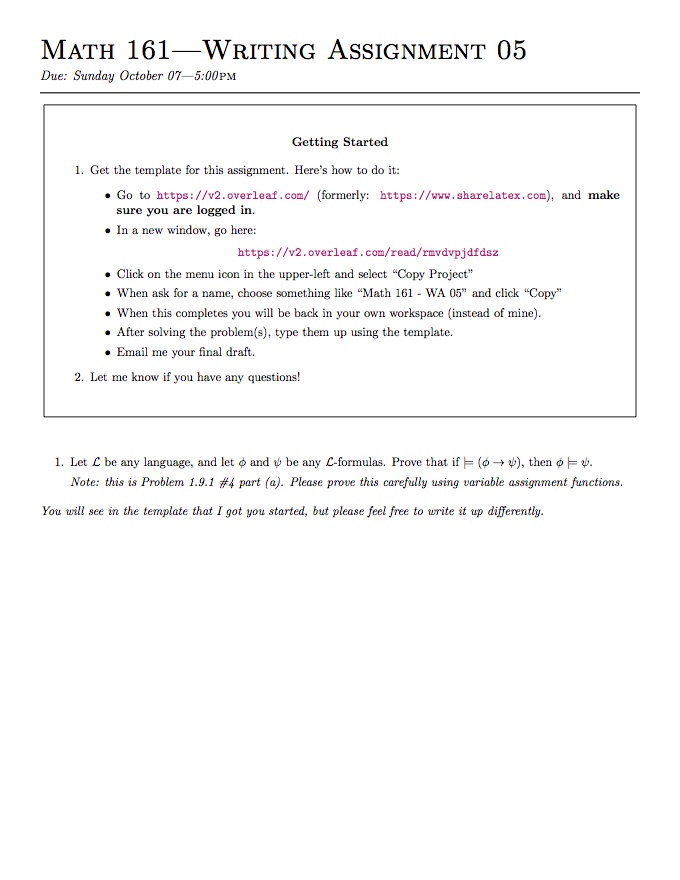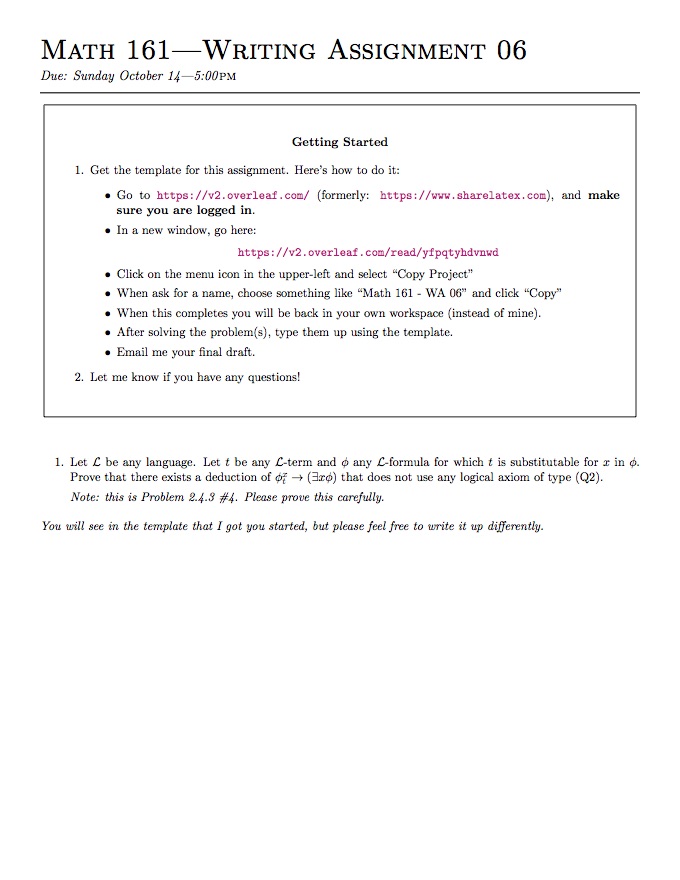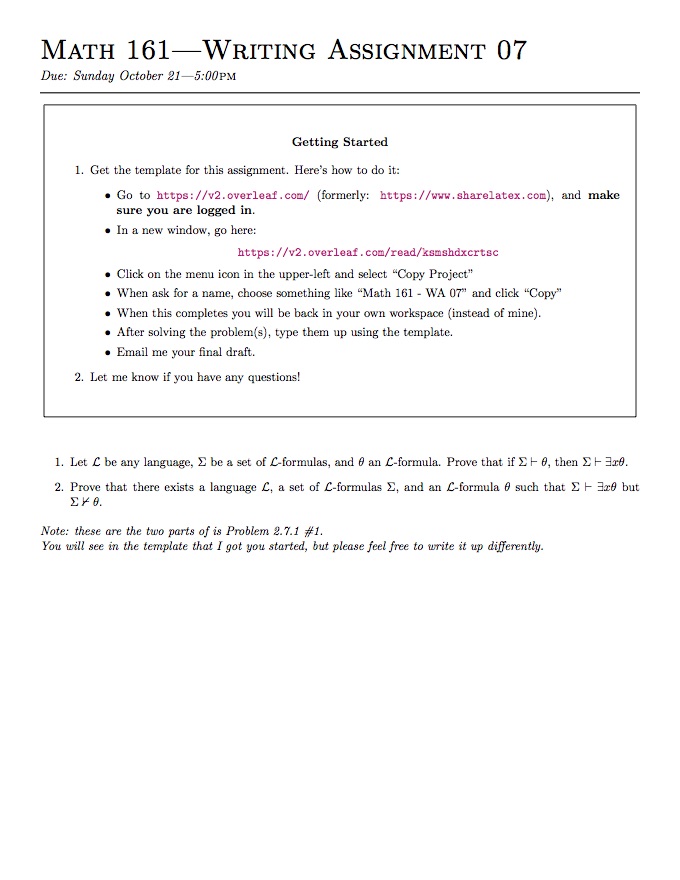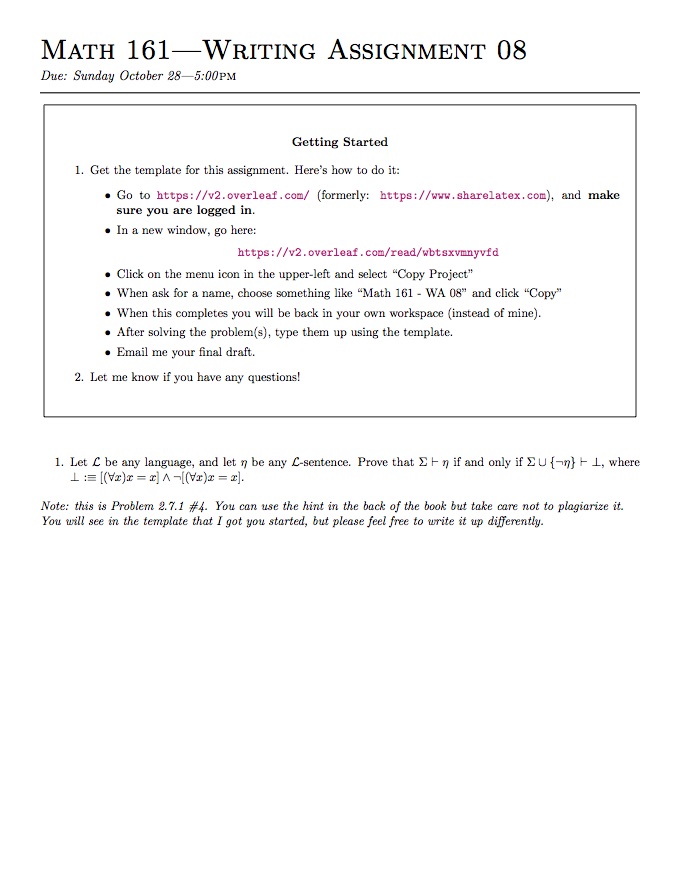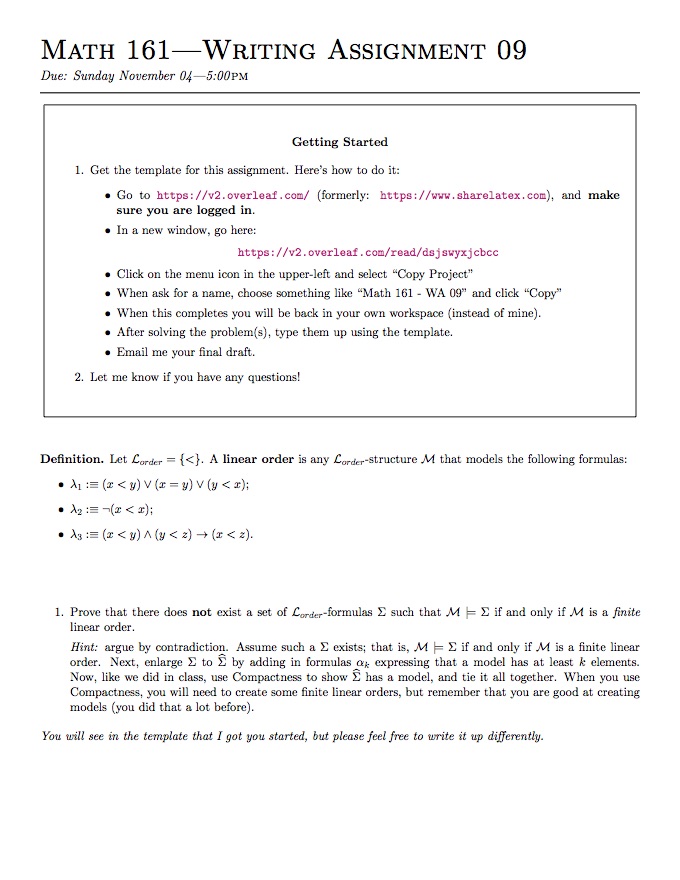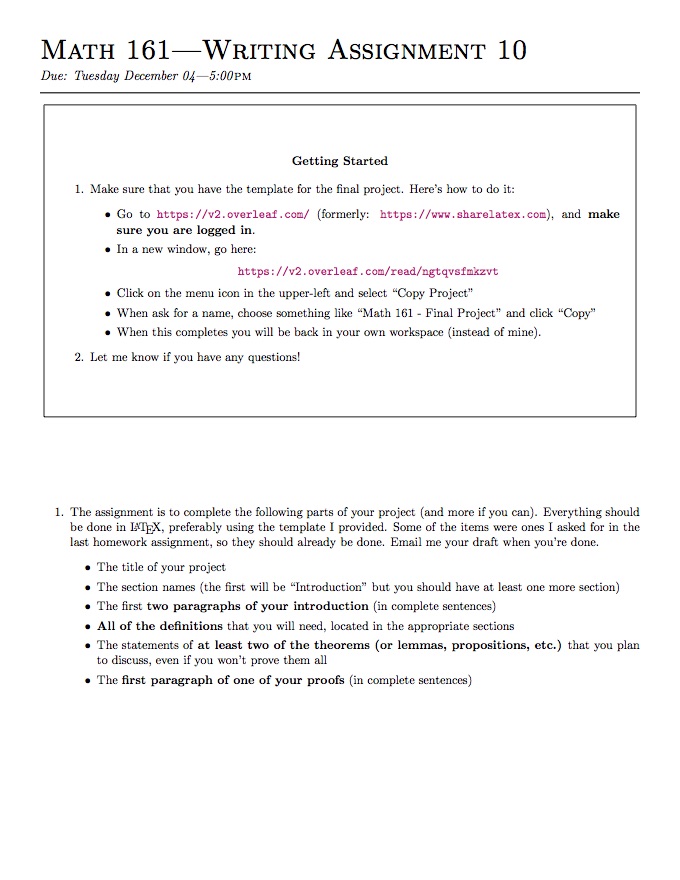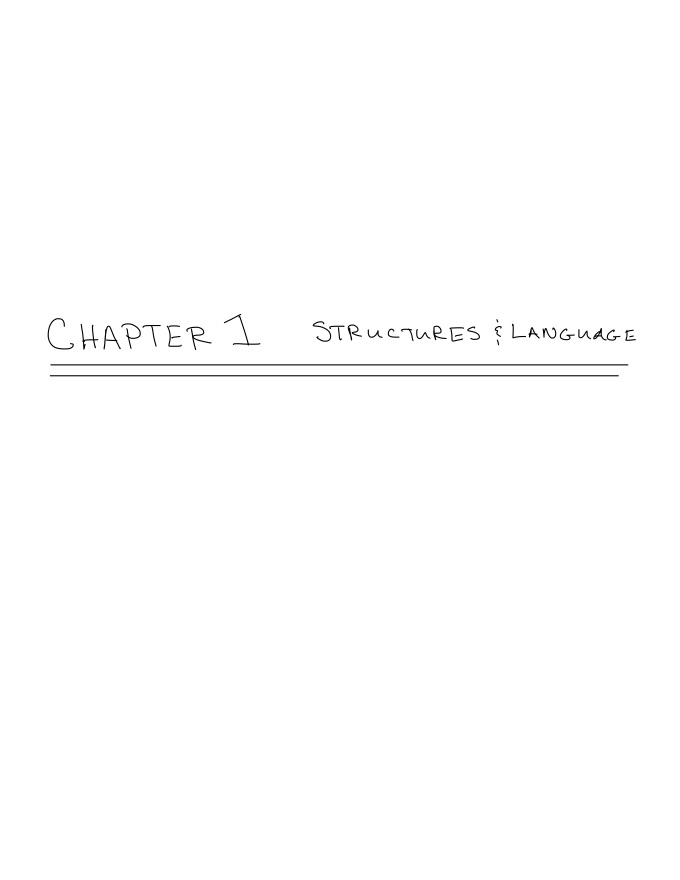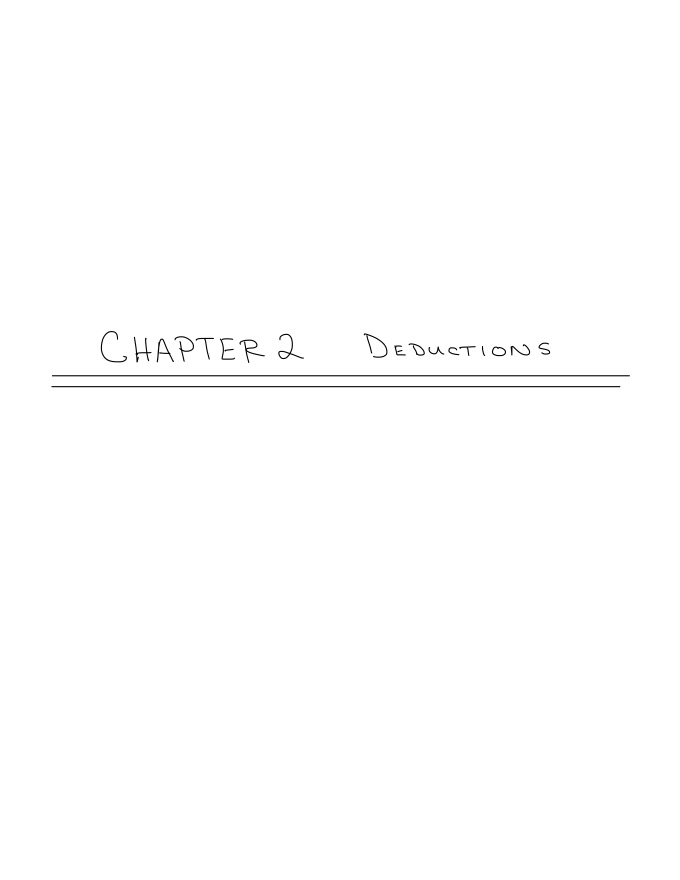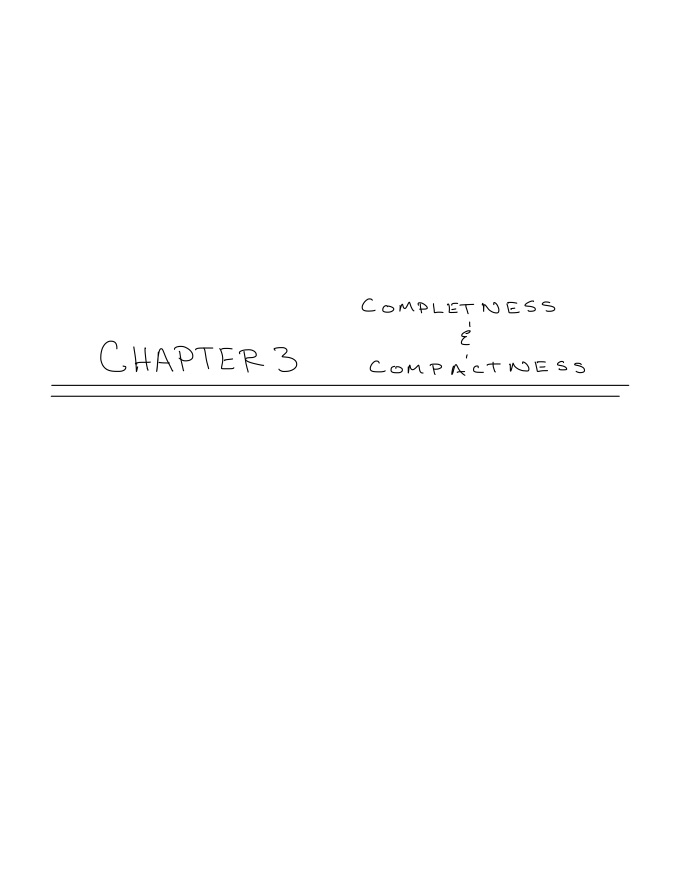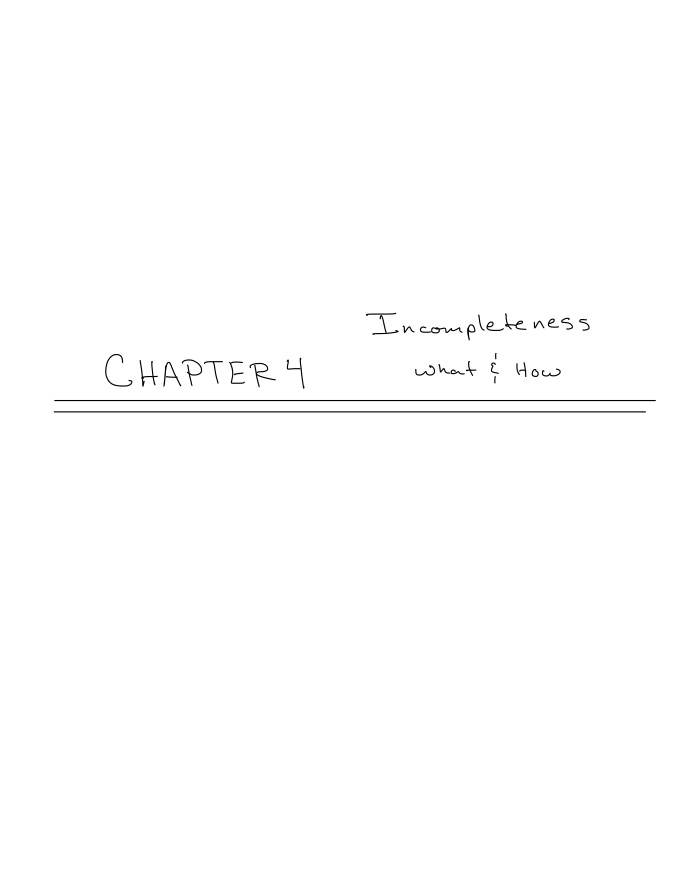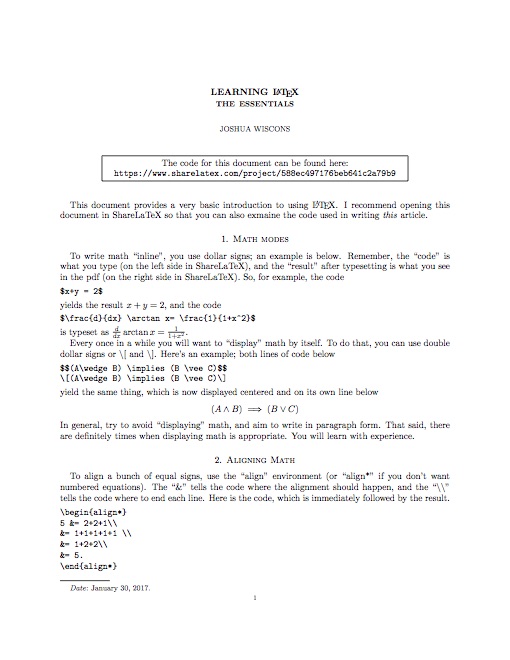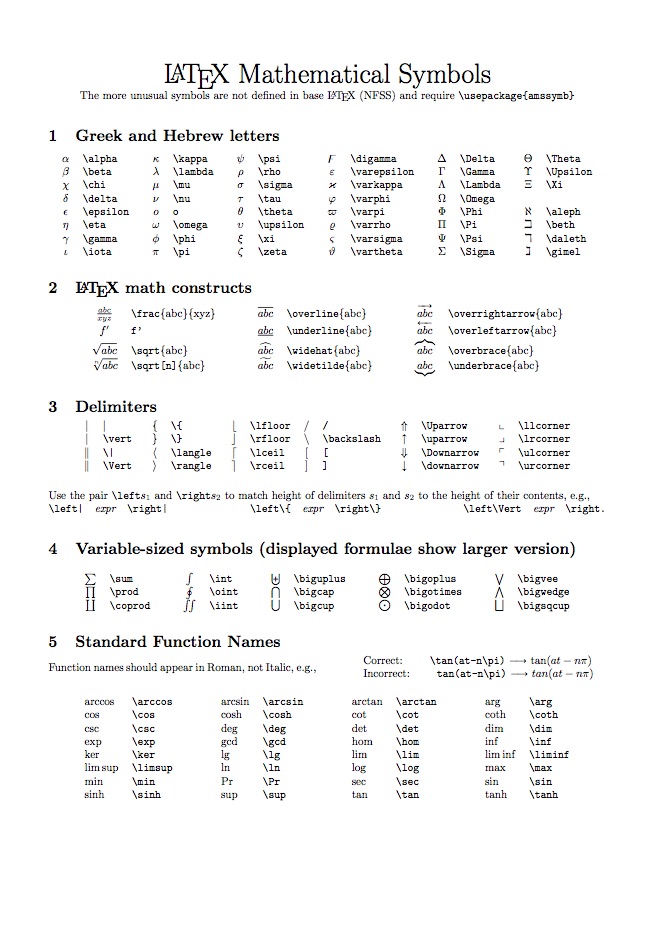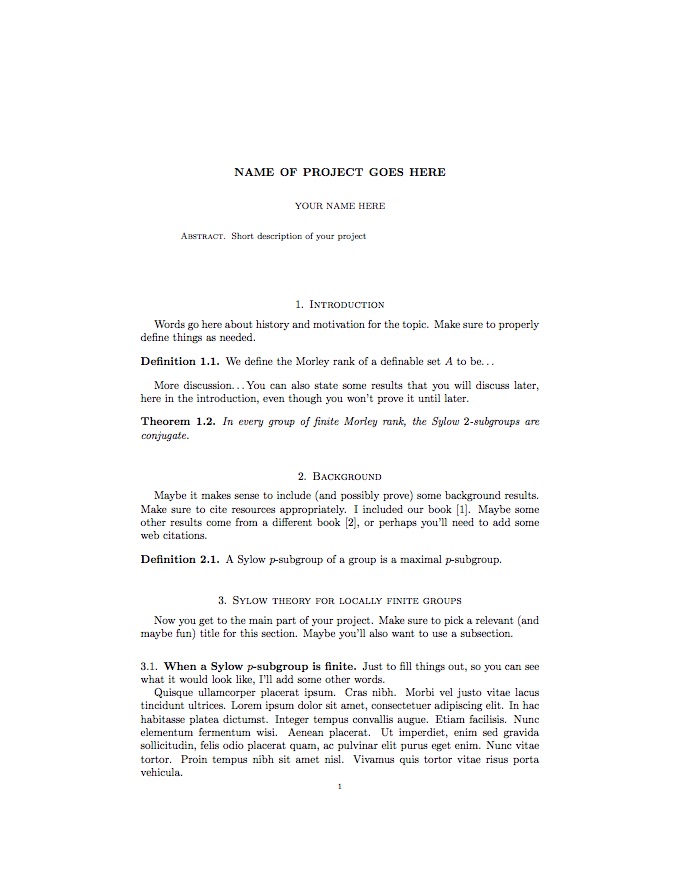"The more I think about language, the more it amazes me that people ever understand each other at all."
Meeting times: TTh 1:30
Office Hours: MW 11:30
Student grades are maintained on Canvas.
Announcements
The homework for next time is to do Writing Assignment 10. It is due Tuesday, and it is about working towards a draft of your project. (There is something to turn in.)
Writing Assignment: See Below
Project Topics (Tentative)
Here is the tentative schedule for the projects.
| 12.06.18 | 12.13.18 | 12.13.18 (cont'd) |
|---|---|---|
| Surreals (AAS) | Lowenhiem-Skolem (DB) | History: Incompleteness (SK) |
| Nonstandard analysis (TB) | Graphs (König's lemma) (TT) | $\Sigma$-formulas and $N$ (JF) |
| Computability (JN) | Nonstandard arithmetic (ODC) | Hyperreals (JM) |
| Other Logics (AA) | Compactness—the details (EK) | |
| Second-order logic (DD) | What $N$ can prove (MDS) | |
| Gödel Numbers (MM) | Validity of $\Lambda$ (AS) |
The Book
We are using A Friendly Introduction to Mathematical Logic, 2nd Edition, by Christopher C. Leary and Lars Kristiansen. The book is free if you use the pdf version—a print version can be purchased for less that $30. It can be found here:
Writing Assignments
Course Notes
Other Handouts
Course Log
| [11.29.18] - Thursday |
|---|
|
Closing in on Gödel's First Incompleteness Theorem... The homework for next time is to do Writing Assignment 10. It is due Tuesday, and it is about working towards a draft of your project. (There is something to turn in.) |
| [11.27.18] - Tuesday |
|
Back at it. Started working towards Gödel's First Incompleteness Theorem. Homework 22Problems to turn in: Please edit the project template to include (a preliminary version of) each of the following. Then, EMAIL me the resulting pdf file or print it our and bring it to class.
|
| [11.20.18] - Tuesday |
|
The university was closed today. The mini-presentations will be cancelled...sadness. Hold on to Homework 21. It will be collected on Nov. 27, the Tuesday after the break. |
| [11.15.18] - Thursday |
|
The university was closed today. Mini-presentations about your projects will start next Tuesday. See the Canvas announcement for more details. Hold on to Homework 21. It will be collected on Nov. 27, the Tuesday after the break. |
| [11.13.18] - Tuesday |
|
The university was closed today. |
| [11.08.18] - Thursday |
|
Homework 21
Reading: Section 4.2 ...Pay attention to where negations can occur in $\Sigma$- and $\Pi$-formulas! Problems to turn in: 4.2.1 #1 and the following: Extra Problem 1. Write down each of the following: a tentative name for your project (this should more detailed that what I have listed on the website); and a 3–5 sentence description of your project, in your own words. |
| [11.06.18] - Tuesday |
|
Homework 20
Reading: Section 4.1 Problems to turn in: Problem 1. Let $\mathbb{R}^*$ denote the hyperreals as constructed in class. Recall that $a\in \mathbb{R}^*$ is infinitesimal if $0< a < r$ for all $r\in \mathbb{R}$. (Also remember that $0< a < r$ is really shorthand for $0< a < c_r^{\mathbb{R}^*}$.) (a) Using the fact that addition is commutative in $\mathbb{R}$, prove that addition is also commutative in $\mathbb{R}^*$. (b) Let $a\in \mathbb{R}^*$ be infinitesimal. Prove that the product $100 a$ is also infinitesimal. (You may want to argue by contradiction.) |
| [11.01.18] - Thursday |
|
Homework 19
Reading: Review what we've done so far in the course. Did you have a favorite topic? (...please say yes...) Any lingering questions? Answers to these could be a good starting point for a project, but I have some ideas too. Problems to turn in: None. (But don't forget the writing assignment.) |
| [10.30.18] - Tuesday |
|
Homework 18
Reading: Section 3.3 Problems to turn in: Problem 1. Let $\mathcal{L}_{Order} = \{< \}$. The axioms for a linear order are as follows.
(a) Give an example of a linear ordering with 4 elements by defining a universe $\mathcal{M}$ and the ordering $<^\mathcal{M}$.
(b) Prove that there does not exist a set of $\mathcal{L}_{Order}$-formulas $\Sigma$ such that $\mathcal{M}\models \Sigma$ if and only if $\mathcal{M}$ is a finite linear order. |
| [10.25.18] - Thursday |
|
Reading: Start reading Section 3.3 Problems to turn in: None. (But don't forget the writing assignment.) |
| [10.23.18] - Tuesday |
|
Homework 17
Reading: Finish Reading Section 3.2 Problems to turn in:
|
| [10.18.18] - Thursday |
|
Homework 16
Reading: Start Reading Section 3.2 Problems to turn in: None |
| [10.16.18] - Tuesday |
|
Homework 15
Reading: Read Section 2.8 (this is an important section to read!) Problems to turn in:
|
| [10.11.18] - Thursday |
|
Homework 14
Reading: Re-read Section 2.7 Problems to turn in:
|
| [10.09.18] - Tuesday |
|
Homework 13
Reading: Re-read Section 2.5 Problems to turn in:
|
| [10.04.18] - Thursday |
|
Homework 12
Reading: Read Section 2.5 Problems to turn in:
|
| [10.02.18] - Tuesday |
|
Homework 11
Reading: Read Section 2.4 Problems to turn in:
|
| [09.27.18] - Thursday |
|
Homework 10
Reading: Read Section 2.2 Problems to turn in:
|
| [09.25.18] - Tuesday |
|
Homework 09
Reading: Read Section 1.8 and 1.9 Problems to turn in:
Problem 1. Work in $\mathcal{L}_{NT}$. Consider the following formulas: $$\begin{align} \phi & :\equiv (\forall x)((0< x) \rightarrow(0< S x))\\ \alpha & :\equiv (\forall x)(0 < SS x))\\ \beta & :\equiv (\neg (0 < S 0)) \vee (0< SS 0) \end{align}$$ (a) True or False (and explain): $\phi \rightarrow \alpha$ is logically valid, i.e. $\vDash (\phi \rightarrow \alpha)$. (b) True or False (and explain): $\phi \rightarrow \beta$ is logically valid, i.e. $\vDash (\phi \rightarrow \beta)$. |
| [09.20.18] - Thursday |
|
Homework 08 (Due Tuesday)
Reading: Read Section 2.1 Problems to turn in:
Problem 1. Let $\mathcal{L} = \{c,g\}$ where $c$ is a constant symbol and $g$ is a unary function symbol. $$\phi :\equiv (\forall x)(\exists y)[(x\neq c)\rightarrow ((y \neq g(x))\wedge (y\neq c))].$$ Prove that there exists an $\mathcal{L}$-structure $\mathcal{M}$ such that $\mathcal{M}\not\vDash \phi$. Hint: this is similar to 1.7.1 #4. Note that proving $\mathcal{M}\not\vDash \phi$ is the same as proving $\mathcal{M}\vDash (\neg\phi)$. As we saw in class, a good starting point is to carefully "simplify" $\neg \phi$ using rules from an Intro. to Proof class (like our Math 108).
Problem 2. Let $\mathcal{L} = \{c,g\}$ where $c$ is a constant symbol and $g$ is a unary function symbol. Define $\phi$ as before: $$\phi :\equiv (\forall x)(\exists y)[(x\neq c)\rightarrow ((y \neq g(x))\wedge (y\neq c))].$$
Also, define $$\psi :\equiv (\exists x_1)(\exists x_2)(\exists x_3)[(x_1\neq x_2)\wedge(x_2\neq x_3)\wedge(x_3\neq x_1)].$$
Prove that if $\mathcal{M}\vDash \psi$ then $\mathcal{M}\vDash \phi$. |
| [09.18.18] - Tuesday |
|
Homework 07 (Due Thursday)
Reading: Reread Section 1.7 Problems to turn in: 1.7.1 #2, #4 |
| [09.13.18] - Thursday |
|
Homework 06 (Due Tuesday)
Reading: Section 1.7 Problems to turn in: Problem 1. Let $\mathcal{L} = \{c,g,P\}$; $c$ is a constant symbol, $g$ is a unary function symbol, and $P$ is a unary relation symbol. Also,
Define two $\mathcal{L}$-structures $\mathcal{M}$ and $\mathcal{N}$ such that
Definition (needed for the Problem 2). If $\phi(x)$ is an $\mathcal{L}$-formula with free variable $x$, $\mathcal{M}$ is an $\mathcal{L}$-structure, and $m\in M$, then $\phi(m)$ is the new formula obtained by replacing all occurrences of $x$ with $m$. For example, if $\phi(x) :\equiv (\exists y)(x+y < x\cdot y)$, then $\phi(3) :\equiv (\exists y)(3+y < 3\cdot y)$. Problem 2. Recall that $\mathcal{L}_R = \{0,1,-,+,\cdot\}$ where $0$ and $1$ are constant symbols, $-$ is a unary function symbol, and $+$ and $\cdot$ are binary function symbols. Let $\mathbb{R}$ be the real numbers considered in the usual way as an $\mathcal{L}_R$-structure (so $-$ means "negative"). Prove that there is an $\mathcal{L}_R$-formula with free variable $x$ such that for every $r\in \mathbb{R}$, Hint: First, remember that $<$ is NOT in the language, so you need to find a way to describe the positive numbers using only $0,1,-,+,\cdot$. Second, feel free to use all connectives and quantifiers explicitly, e.g. $\exists$, $\rightarrow$, etc. Definition (needed for Problem 3). Remember that if $\phi$ is an $\mathcal{L}$-sentence and $\mathcal{M}$ an $\mathcal{L}$-structure, we write $\mathcal{M} \vDash \phi$ if $\phi$ is a true statement about $\mathcal{M}$. Now, if $\Delta$ is a (possibly infinite) set of $\mathcal{L}$-sentences, we write $\mathcal{M} \vDash \Delta$ if every sentence in $\Delta$ is a true statement about $\mathcal{M}$. Problem 3. Let $\mathcal{L}$ be any language and $\mathcal{M}$ any $\mathcal{L}$-structure. Find a set of $\mathcal{L}$-sentences $\Delta$ (which can be finite or infinite) such that |
| [09.11.18] - Tuesday |
|
Homework 05 (Due Thursday)
Reading: Section 1.6 Problems to turn in: Problem 1. Let $\mathcal{L} = \{c,g,E\}$ where $c$ is a constant symbol, $g$ is a unary function symbol, and $E$ is a binary relation symbol. Define an $\mathcal{L}$-structure $\mathcal{M}$ meeting the following criteria:
|
| [09.06.18] - Thursday |
|
Homework 04 (Due Tuesday)
Reading: Sections 1.5, 1.6 Problems to turn in:
|
| [09.04.18] - Tuesday |
|
Homework 03 (Due Thursday)
Reading: Sections 1.3, 1.4 (I highly recommend rereading 1.3!) Problems to turn in: 1.3.1 #1, #3 (Only do the first paragraph of #3; you can stop after Lagrange's Theorem.) |
| [08.30.18] - Thursday |
| If you haven't already, make sure to sign up for a ShareLaTeX account and get started on Writing Assignment 01. It's due Saturday! |
|
Homework 02 (Due Tuesday)
Reading: Sections 1.2 and 1.3 (of the Leary-Kristiansen book) Problems to turn in: 1.2.1 #7 and the problems below... Extra Problem 1. Write down 3 terms of $\mathcal{L}_{NT}$. Make sure some of your terms include function symbols (and not just constants and variables). Please write each term twice: once in prefix notation (also called Polish notation) and once the "usual" way with infix notation. Extra Problem 2. Write down 4 formulas of $\mathcal{L}_{NT}$ such that 2 of the formulas are atomic and 2 are not atomic. Please write each formula twice: once in prefix notation and once with infix notation. |
| [08.28.18] - Tuesday - First day! |
| Great to meet you all! Make sure to sign up for a ShareLaTeX account and get started on Writing Assignment 01. It's due this coming Saturday! |
|
Homework 01 (Due Next Time)
Reading: Preface, Intro. to Chap. 1 and Section 1.1 (of the Leary-Kristiansen book) Problems to turn in: Problem 1. Read about Goldbach's Conjecture on Wikipedia. Then, do the following.
|
